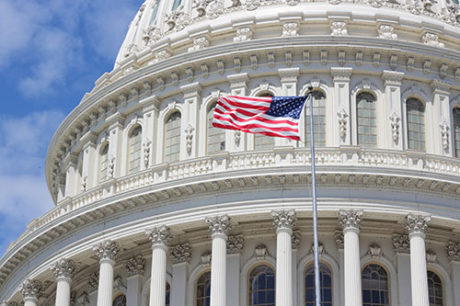Budget Law Said to Be Ignored
Minus a budget, House and Senate appropriators still haven’t been given new formal discretionary spending numbers and have had to modify their own practices to start advancing the first of the 12 bills. ( Link to graphic, left, with hyperlinks.)
House Appropriations Committee Chairman Rodney Frelinghuysen (R-N.J.) had to abandon the tradition of starting with the committee approval of an overall allocation and then dividing that into 12 pieces. Instead, Frelinghuysen got an unofficial number of $1.132 trillion from House leaders and began by front-loading security-related bills. His plan provides about $70 billion more for defense programs while cutting $7.8 billion from the non-defense side.
In contrast, McConnell instructed the Senate Appropriations Committee led by Sen. Thad Cochran (R-Miss.) to start moving bills to reflect this year’s $1.070 trillion discretionary spending total. Six of 12 were marked up before the August recess, and aides said more are likely to move in September.
The House plan violates the BCA and, unless the law’s defense cap is amended, there will have to be across-the-board cuts of about $70 billion to get the defense number in line with the $549.1 billion cap, Hoagland said.
“Everybody knows we have a statutory limit on spending for defense and non-defense. It’s the law of the land,” he said. “They can put together whatever appropriations bills they want, but at the end of the day, those caps are binding.”
The only way to achieve higher spending is for leaders to strike another bipartisan budget deal easing the BCA’s caps, Hoagland said. Lawmakers twice have made two-year bipartisan deals that provided relief from the law.
A plan sharply boosting defense at the expense of non-defense could still be implemented, Collender said.
“Given that Trump is a bit of a loose cannon when it comes to obeying the law, what would happen if Congress passes appropriations bills that would cause the caps—particularly for defense—to cause a sequester but he ordered [White House budget director] Mick Mulvaney not to implement the law?” Collender said. “Here’s the thing: What used to be unimaginable is now merely unlikely.”
‘Fake Numbers’ Put to Test
A number of House appropriators—including Military Construction and Veterans Affairs Subcommittee Chairman Charlie Dent (R-Pa.)—have said they don’t expect the “fake numbers” in their bills to become law, and still expect a bipartisan negotiation will raise the caps and give them the final figures.
But in the meantime, Ryan is planning to move the unfinished appropriations bills to the House floor as soon as the week of Sept. 4. The plan is to bring up those eight measures and then use a rule to combine them with the four already contained in the House-passed security “minibus” ( H.R. 3219), House aides said. Ryan then plans to try to send that 12-bill omnibus to the Senate, where it will be up to McConnell to bring it up on the floor, they said.
Senate Democrats are expected to oppose the measure, meaning McConnell is unlikely to get the 60 votes needed to begin debate. After that exercise, leaders will have to settle on a more realistic strategy to prevent a funding lapse at the end of the month, aides said.
The need to raise the debt limit essentially is going to coincide with the government funding deadline, Hoagland said, adding that there is a good chance that GOP leaders may try to use the CR to extend the debt limit. A provision to help stabilize Affordable Care Act insurance markets may make it into the CR, as may Trump’s new request for “emergency” money to combat the opioid crisis, he said.
Maya MacGuineas, president of the Committee for a Responsible Federal Budget, expects leaders will be pondering how to avoid a default as lawmakers are trying to head off a government shutdown, she said.
“Both are really bad—but default is unimaginably bad,” MacGuineas said. “It’s territory we haven’t entered before. I’m an optimist that we will get both of these done. But it’s not a clear path to getting them to the finish line for either of them yet.”
‘Unimaginably Bad’
If a stopgap to head off a shutdown is passed, House and Senate leaders will have bought themselves time to negotiate a new budget deal, revise the spending bills, and get a final package through both chambers. But that won’t be easy, and Ryan and McConnell may need to have the CR extend through Dec. 15.
Both the House and Senate ignored the revised BCA discretionary spending cap for fiscal 2018 because the $1.065 trillion in base funding translates into a $5 billion cut from current funding—$2 billion from defense and $3 billion from non-defense programs. By instead following this year’s $1.070 trillion level, the Senate Appropriations Committee was able to write bills without those cuts. But lawmakers there and at the House Appropriations Committee both want to boost funding above current levels.
Democrats said they aren’t opposed to Republicans’ efforts to increase defense but won’t accept cuts to non-defense to achieve the increases. Democrats said before the recess that they would support increasing defense $54 billion above post-sequester spending caps as long as non-defense is also increased by $54 billion.
Lawmakers’ goal is to get another deal revising the levels upward for two more years, Hoagland said.
Collender is increasingly less sure about whether that kind of agreement is possible in the run-up to the midterm election, he said.
“I don’t think Democrats want to take those issues away,” Collender said. “They want them to be front and center.”
A six-part mini-deal that may get more interest calls for replacing about two-thirds of the sequester and increasing the caps for both defense and non-defense, MacGuineas said.
‘Future Returns’
GOP leaders’ goal is said to be passage of another omnibus by year’s end that wraps up spending and possibly becomes a vehicle for many non-spending matters, perhaps even tax legislation.
But Collender said he is less optimistic that such a package is possible this year.
“It’s what they say in the prospectus: Past performance is no indication of future returns,” Collender said.
“Unless this gets a lot better soon, they could easily do a CR and go home in December and live to fight another day,” he added. “The president will be upset, but he’s not up for re-election in 2018.”












0 responses on "No deals in sight as spending, debt limit deadlines loom"